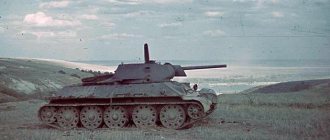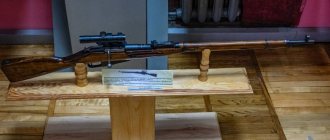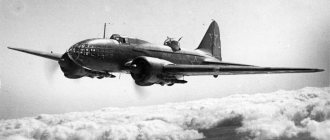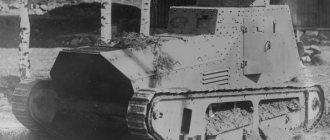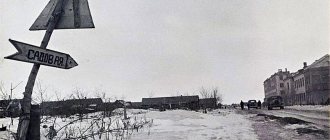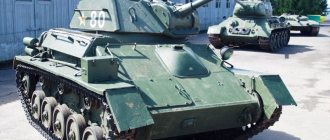How many tanks were there in the Soviet mechanized corps?
The article shows the number of tanks, manning, technical condition and the presence of new equipment in all Soviet 20 mechanized corps, right before the start of the German invasion of the USSR in 1941.
Data for the five western military districts of the USSR are given as of 06/01/1941, however, in terms of the number of tanks under repair and actually in service, the data differs, and by an order of magnitude. The difference reaches 2000 cars!
The problem is connected with a rather simple formality: if you count tanks only in mechanized corps, then there are 10,394 of them, but if you add to them the combat vehicles that were part of some rifle, cavalry and individual tank units of the military district, then the number will be more serious: 12782 tanks.
Accordingly, for each mechanized corps I will provide data on its strength, and data on repairs (general) will be given for the military district as a whole.
The clause “among them modern” means tanks that were put into service in the last years before the war: T-34 model 1940 , KV-1 , KV-2 , and other small-scale vehicles like the T-50 . In total, at the beginning of the war there were 1,325 such vehicles in the army.
Let me remind you that the bulk of the Red Army tanks at the beginning of the war were light T-26 , BT-7, BT-5 , etc.
Most of the mechanized corps, intended to conduct independent actions and break through the enemy’s defenses, were subordinate directly to the district (or the front in war conditions), but they were also assigned to combined arms armies, which were entrusted with covering the state border.
The mechanized corps (at the beginning of the war) included two tank and one motorized divisions, located from one another at a distance of sometimes 50–100 km, which sharply reduced the effectiveness of using this, on the one hand, very cumbersome, and on the other, loose military formation.
After the reorganization in 1942, the mechanized corps (while maintaining the previous name) received a completely different principle of organization and became a much more effective military force.
Panther tanks became part of the Wehrmacht and SS tank divisions
Before the Battle of Kursk
, in May 1943, the 51st and 52nd separate tank battalions received new Pz Kpfw V Panther tanks. In June 1943, the SS panzergrenadier divisions Das Reich and Leibstandarte SS Adolf Hitler were armed with Panther tanks.
By state 1944
. The Wehrmacht tank division had a 2-battalion tank regiment. The first battalion was armed with Pz.Kpfw V "Panther" tanks, the second - with Pz.Kpfw IV tanks. The battalion consisted of four companies of 17 tanks each. There were 8 tanks at the headquarters. In total, the Panther tank battalion was supposed to have 76 tanks. The battalion also included a sapper platoon, an air defense platoon, armed since the summer of 1944 with 37-mm Möbelwagen self-propelled anti-aircraft guns or 20-mm four-barreled Virbelwind self-propelled guns, and a technical company equipped with ARVs. In fact, the Wehrmacht tank battalions had an average of 51-54 Panthers, and the SS troops had up to 64 Panthers. In fact, not all Wehrmacht tank divisions received Panther tanks. In 1944, in some tank regiments, both battalions were armed only with Pz Kpfw IV tanks.
Leningrad Military District
1st Mechanized Corps
- Staffing: 31,348 people (87%)
- Number of tanks: 1506 units in both mechanized corps of the district (no separate data).
- Of these, modern: 15 units in both mechanized corps of the district (there are no separate data, the exact type of tanks is unknown).
10th Mechanized Corps
- Staffing: 26065 people (72%)
- Number of tanks: 1506 units in both mechanized corps of the district (no separate data, the exact type of tanks is unknown).
- Of these, modern: 15 units in both mechanized corps of the district (there are no separate data, the exact type of tanks is unknown).
For the district as a whole:
- Fully operational tanks: 7
- Requiring minor repairs: 1536
- Requiring long-term repairs (not running): 210
- Requiring major repairs (not running): 104
Baltic Military District
3rd Mechanized Corps
- Staffing: 31975 people (87%)
- Number of tanks: 1393 units in both mechanized corps of the district (no separate data).
- Of these, modern: 109 units in both mechanized corps of the district (no separate data, 59 units KV-1 and 50 units T-34).
12th Mechanized Corps
- Staffing: 29998 people (83%)
- Number of tanks: 1393 units in both mechanized corps of the district (no separate data).
- Of these, modern: 109 units in both mechanized corps of the district (no separate data, 59 units KV-1 and 50 units T-34).
For the district as a whole:
- Fully operational tanks: 378
- Requiring minor repairs: 896
- Requiring long-term repairs (not running): 203
- Requiring major repairs (not running): 72
Western Special Military District (until 07/11/1940 - Belarusian Military District)
6th Mechanized Corps
- Staffing: 24,005 people (67%)
- Number of tanks: 1021 pcs.
- Of these, modern: 352 units (113 KV-1)
11th mechanized corps
- Staffing: 21,605 people (60%)
- Number of tanks: 237 pcs.
- Of these, modern: 31 pieces (exact type unknown)
13th Mechanized Corps
- Staffing: 17809 people (49%)
- Number of tanks: 294 pcs.
- Of these modern: 0 pieces (exact type unknown)
14th Mechanized Corps
- Staffing: 15550 people (43%)
- Number of tanks: 520 pcs.
- Of these modern: 0 pieces (exact type unknown)
17th Mechanized Corps
- Staffing: 16578 people (46%)
- Number of tanks: 36 pcs.
- Of these modern: 0 pieces (exact type unknown)
20th Mechanized Corps
- Staffing: 20389 people (57%)
- Number of tanks: 93 pcs.
- Of these modern: 0 pieces (exact type unknown)
For the district as a whole:
- Fully operational tanks: 470
- Requiring minor repairs: 1722
- Requiring long-term repairs (not running): 385
- Requiring major repairs (not running): 323
Typical composition of a Wehrmacht tank division
Strengths and means
| 1941 - 1942 | 1943 1944 1945 | |||
| Personnel (in thousands) | 16 | 16,9 | 14,7 | 11,4 |
| Tanks | 160-221 | 200 | 170 | 40 |
| self-propelled guns | — | 57 | 46 | 40 |
| Armored vehicles | 25 | 40 | 20 | 16 |
| Guns and mortars | 192 | 154 | 135 | 122 |
| Armored personnel carriers | 160 | 172 | 288 | 90 |
| Motorcycles | 788 | 401 | 350 | |
| Cars | } 2915 | 2147 | 2084 | 2171 |
| Tractors | 200 | 125 | 115 | |
The decrease in the number of tanks in the armored divisions was partially compensated by the increased firepower of the panzergrenadier regiments, despite the fact that their size decreased. In 1939, the tank division was armed with four rifle companies and a motorcycle battalion with 110 light and 56 heavy machine guns, 36 50 mm and 24 80 mm mortars, eight light infantry guns and twelve 37 mm PaK36 anti-tank guns. In 1944, the tank division was armed with four panzergrenadier battalions should have had 364 light and 49 heavy machine guns, there were no light mortars, 24 80-mm and 16 120-mm heavy mortars, twelve heavy infantry guns, twelve 75-mm infantry guns and 40 20 mm anti-aircraft guns. Anti-tank guns were assigned to anti-tank divisions, each of which had forty-three 75 mm PaK40 guns.
In March 1945
The tank division had a mixed tank regiment, which consisted of a tank battalion and a battalion of panzergrenadier armored personnel carriers. The tank division included 2 more panzergrenadier regiments on trucks (2 battalions each), an artillery regiment (a division of self-propelled guns "Wespe" and "Hummel", two motorized artillery divisions), a mixed anti-tank division (75-mm anti-tank guns and fighters Jagdpanzer tanks) and a sapper battalion.
Thus, in the statewide tank division there was a significant increase in the proportion of panzergrenadiers. The division now included five panzergrenadier battalions and one tank battalion. According to the 1945 staff, the tank division had only 54 tanks and self-propelled guns, including the Jagdpanzer tank destroyers, which were part of the anti-tank divisions. Most divisions had much fewer tanks.
Kyiv Military District
4th Mechanized Corps
- Staffing: 28097 people (78%)
- Number of tanks: 892 pcs.
- Of these, modern: 416 units (89 KV and 327 T-34)
8th Mechanized Corps
- Staffing: 31927 people (89%)
- Number of tanks: 858 pcs.
- Of these, modern: 171 units (7 KV-1, 2 KV-2, 100 T-34)
9th Mechanized Corps
- Staffing: 26833 people (74%)
- Number of tanks: 285 pcs.
- Of these modern: 0 pieces (exact type unknown)
15th mechanized corps
- Staffing: 33935 people (94%)
- Number of tanks: 733 pcs.
- Of these, modern: 131 units (64 KV, 69 T-34)
16th Mechanized Corps
- Staffing: 26,380 people (73%)
- Number of tanks: 608 pcs.
- Of these modern: 0 pieces (exact type unknown)
19th mechanized corps
- Staffing: 22654 people (63%)
- Number of tanks: 280 pcs.
- Of these, modern: 7 pieces (5 KV, 2 T-34)
22nd Mechanized Corps
- Staffing: 24087 people (67%)
- Number of tanks: 647 pcs.
- Of these, modern: 31 pieces (KV-2)
24th Mechanized Corps
- Staffing: 21556 people (60%)
- Number of tanks: 222 pcs.
- Of these modern: 0 pieces (exact type unknown)
For the district as a whole:
- Fully operational tanks: 1124
- Requiring minor repairs: 3644
- Requiring long-term repairs (not running): 298
- Requiring major repairs (not running): 379
New in blogs
About the defeat of the Soviet 5th Tank Army in July 1942.
My article is based on extensive research by Igor Yu. Sdvizhkov. Unfortunately, I cannot indicate the title of his book, but I think it will be easy for those interested on the Internet to find it by the name of the author.
People far from military history may not read the extensive discussions below.
* * *
When planning Operation Blau (summer 1942), the German command foresaw that after the Wehrmacht strike forces reached the Don and turned south, large flank attacks from the Yelets area should be expected from the Red Army. The calculation turned out to be correct.
Beginning on June 28, the German offensive developed successfully. At the same time, units of the German 4th Panzer Army (Hoth) were significantly ahead of the infantry divisions. On July 4, the advanced units of the Wehrmacht crossed the Don and aimed to capture Voronezh. And the Soviet command hastily transferred the 5th TA (tank army) A.I. Lizyukov to the Yelets area, and made the fatal decision to launch a counterattack without waiting for its complete concentration .
The counterattack of the 5th TA on the flank and rear of the advancing German group could indeed completely change the operational situation in the Voronezh direction and thwart the far-reaching plans of the German command (a breakthrough along the Don to Stalingrad and further to the Caucasus). But the calculations of the Soviet generals were based on the overly arrogant assumption that our counteroffensive would be unexpected for the Germans. to haste, proper reconnaissance in the direction of the proposed attack was practically not carried out, and on July 6, tankers of the 5th TA, its forward 7th Tank Corps (tank corps) P.A. Rotmistrov went into battle, not knowing where the enemy was and what forces he had.
Meanwhile, German aerial reconnaissance discovered the transfer of units of the 5th TA on July 4th. Therefore, the command of the German 4th TA managed to deploy the 9th TD (tank division) in advance to the north and cover its left flank at the Zemlyansk-Livenka line. Thus, the Germans forestalled our attack by a day, having time to prepare to repel a counterattack by the Soviet tank army.
So, on the morning of July 6, 1942, instead of weak barriers and unprotected transport columns, the vanguard of the 5th TA suddenly encountered a large enemy tank group. The advancing forward brigades of the 7th Tank Corps suddenly came under a massive attack (about 100 vehicles) by the German 33rd Tank Regiment. Our 87th Tank Brigade was broken up piece by piece and began to retreat. Pursuing her, the Germans captured the bridge over the Kobylya Snova River and did not allow the approaching 19th Tank Brigade to cross to the southern bank.
On the left flank of the 9th Division, between the groves, the enemy set up an ambush and the advance detachment of the 62nd Tank Brigade fell into it. was completely destroyed.
The oncoming tank battle on July 6 immediately turned against the 7th Tank. His attack on Zemlyansk was thwarted, his vanguard suffered heavy losses and rolled back. True, the Germans could not develop their success. Having encountered stubborn resistance from Soviet troops during the battle and noticing the approach of new units, they realized that the Soviet counterattack was being delivered by much larger forces. Therefore, the 9th TD went on the defensive and for 2 days successfully held back the onslaught of the superior forces of the Soviet 5th TA. On July 8, the German 11th tank arrived in time to help the 9th. And on the night of July 10, the German infantry of the 7th Army Corps began to occupy the defense lines of the tank divisions. On July 11, it became clear to the Soviet command that the counterattack of the 5th TA had failed.
Losses of the parties in the battle on July 6:
The Soviet 7th TK lost 52 tanks (44 T-34 and 8 light T-60) and approx. 500 people were killed, wounded and captured.
Burnt-out 34s at the side of the road. Summer 1942
The German 9th TD lost 7 tanks and 35 people. killed and 61 wounded. By evening, the division had 79 combat-ready tanks left (7 T-IV, 60 T-III and 12 T-II).
A damaged German three-ruble note. Summer 1942
The ratio of losses in tanks is 7:1, and in people – 5:1 in favor of the Germans.
And this despite the fact that our T-34 in armament (76-mm cannon) and armor protection (52-45 mm) was superior to German tanks, most of which were Pz.III with a 50-mm gun and 30-mm armor.
The reasons for the success of the Germans and our defeat
1. When faced with superior T-34s, German tank units often used the following tactics. They preferred to make way for the attacking enemy and, covering his flanks, hit the Soviet tanks on the vulnerable side. At the same time, the advantages of the T-34 were lost, and the disadvantages were fully revealed. Our "thirty-four" suffered from poor visibility; moreover, its commanders, being at the same time gunners, focused their attention forward and did not have time to observe to the sides.
2. The Germans have always strived for the massive use of tanks. They tried to use their tank forces as a single whole and not split them into separate units, each with its own mission. This is exactly how the tanks of the enemy 9th TD acted as a single mass against our 7th TC. On the contrary, the Soviet command led the offensive with scattered tank brigades and even battalions. Gathering their tanks into a single fist, the enemy beat our tank units piece by piece. Thus, having half as many tanks (about 100 versus 245), the German command achieved local numerical superiority at decisive moments of the battle. Having the opportunity to attack on a wider front, the Germans covered the Soviet tank battalions from the flanks and destroyed our tanks with massive crossfire, shooting them on the side from close ranges.
3. The commander of the German 9th TD, Major General Johannes Bessler, was in the battle formations of his units and directly observed the progress of the battle and quickly responded to changes in the situation. While the commander of the Soviet 7th TC Pavel Rotmistrov was 10 km from the front line at his command post in Vistula Polyana and practically did not control the battle.
4. Faced with a superior enemy, our advanced tank battalions had to avoid the battle and retreat to join the main forces of the advancing corps. The combined attack of even two Soviet tank brigades deprived the Germans of any hope of maneuver and success. In a frontal battle, the “thirty-fours” would simply shoot German tanks from long distances. But the brigades of the 7th TC had separate tasks, acted separately and fought without interacting or helping each other. The brigade commanders - each bound by the fulfillment of their specific task - could not independently make decisions in an unforeseen situation; they requested distant headquarters and wasted time irrevocably. Reports and orders came for hours. There was no operational communication.
5. German 9th TD. by the summer of 1942 she was already a veteran of the Eastern Front; it was a well-knit and experienced formation. The division command at all levels acted confidently, clearly, and harmoniously. The brigades of the Soviet 7th TC went into battle for the first time. The hasty formation of our new tank formations in the spring of 1942 led to the fact that their personnel, for the most part, did not have the necessary combat experience. For the first time, commanders led large units; tank crews had not sufficiently mastered the technology and were poorly prepared tactically. The commander of the 5th TA himself is Major General A.I. Lizyukov - before that he only headed the rifle (infantry) corps, that is, he was neither a tanker nor an army commander. Colonel Rotmistrov also led a tank corps in battle for the first time, and before that he commanded only a tank brigade. Etc.
6. The victory of the German tankers (two tank divisions of the 9th and the approaching 11th), who defeated the Soviet 5th Tank Army in the battles of July 6 - 11, 1942, was undoubtedly achieved by the fact that the enemy command was not only skillfully used all the means at its disposal, but also worked closely with its artillery and aviation. While our 5th TA had only a very slight artillery reinforcement, and received no air support at all. German fighters, bombers and reconnaissance aircraft operated with impunity over the battlefield.
Conclusions:
Haste, as you know, is only needed when catching fleas and diarrhea , but not when planning and carrying out an army operation.
If you don't know the ford, don't go into the water! Intelligence is half the success.
Suvorov said:
Fight not with numbers, but with skill . For a scientist they give three non-scientists. Three is not enough for us, give us six. Six is not enough for us, give us ten for one. We'll beat everyone, knock them all down, and take them all to pieces .
It's a shame that these rules were followed more by the Germans and not by us.
And here’s another problem: this scholarship is created over generations and carefully preserved by military tradition…. But God forbid the revolution, the next reformers will scatter all this wisdom into dust and teach us anew in blood. Which, in fact, is what the above story proves. Only by 1944 did Soviet tank forces reach the necessary organizational, technical and, so to speak, intellectual level.
And our soldiers who died, although heroically, for the next training, alas, cannot be returned! Never!
Odessa Military District
2nd Mechanized Corps
- Staffing: 32396 people (90%)
- Number of tanks: 489 pcs.
- Of these, modern: 60 pieces (10 KV and 46 T-34)
18th Mechanized Corps
- Staffing: 26879 people (75%)
- Number of tanks: 280 pcs.
- Of these modern: 0 pieces (exact type unknown)
For the district as a whole:
- Fully operational tanks: 178
- Requiring minor repairs: 565
- Requiring long-term repairs (not running): 151
- Requiring major repairs (not running): 117
Source: compilation based on publicly available information on the Internet
Battle groups of tank divisions of the Wehrmacht and SS troops
Tank divisions of the Wehrmacht and SS troops could be divided into battle groups
(Kampfgruppe), capable of conducting combat operations independently. At the end of 1941 and the beginning of 1942, the battle groups included a tank battalion of 40-60 tanks, a motorized infantry battalion with armored personnel carriers and an artillery battalion
Beginning in 1943, combat-ready units of the division were united into combat groups to carry out attacks and counterattacks. These groups included the best tanks, assault guns, Vespe self-propelled guns and armored personnel carriers.
In 1944-1945, armored division combat groups proved particularly useful, serving as "fire brigades" that carried out quick and powerful counterattacks to hold back enemy advances. Operating on the defensive, these battle groups remained faithful to Guderian's pre-war concept of combined mobile formations that included tanks, motorized infantry and artillery. In the last months of the war, the concept of battle groups was improved: the importance of panzergrenadiers in the tank divisions of the Wehrmacht and the SS troops increased even more.
